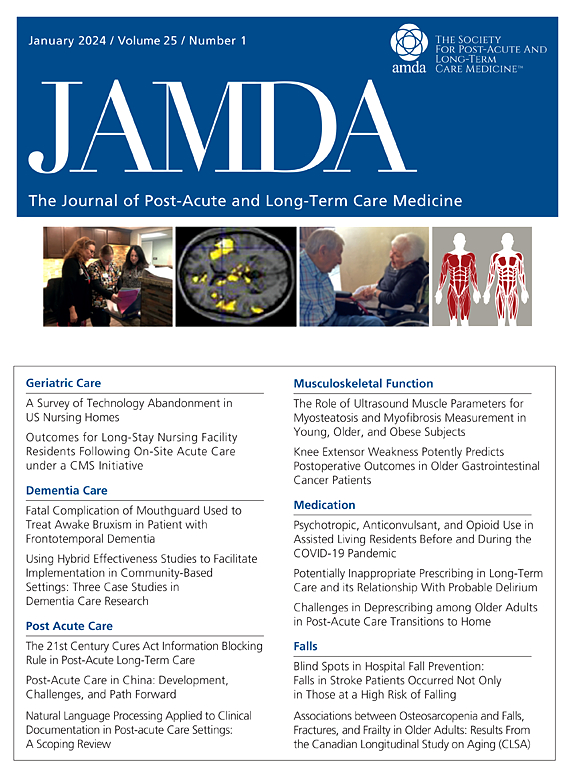老年髋部骨折患者的多维虚弱与术后预后之间的关系:一项范围综述。
IF 4.2
2区 医学
Q2 GERIATRICS & GERONTOLOGY
Journal of the American Medical Directors Association
Pub Date : 2025-07-25
DOI:10.1016/j.jamda.2025.105769
引用次数: 0
摘要
目的:髋部骨折是老年人跌倒引起的一种常见损伤,严重影响其日常活动的灵活性和独立性,并大大增加死亡风险。最近的研究表明,老年髋部骨折患者的虚弱与术后不良后果密切相关。然而,大多数现有研究主要集中在单一维度的脆弱性评估上,缺乏对多维脆弱性对术后结果综合影响的全面认识。因此,本综述系统总结了多维脆弱性与术后不良后果之间的关系,并探讨了多维脆弱性评估工具在老年髋部骨折患者中的应用和有效性。设计:对老年髋部骨折患者的多维虚弱与术后不良后果之间的关系进行范围综述。背景和参与者:与老年髋部骨折患者多维虚弱相关的原始研究。方法:利用PubMed、Embase、Cochrane、Web of Science、CINAHL、PsyInfo等数据库进行综合文献检索。根据预先确定的纳入和排除标准选择研究。提取并分析纳入研究的基本特征、研究设计、脆弱性维度、评估工具和术后结果。结果:共纳入21项研究,主要是回顾性和前瞻性队列研究,最近发表的研究明显增加。不同研究的多维脆弱性评估工具差异很大,既有广泛使用的工具,也有新开发的工具。身体、认知、心理和营养方面的问题最常被提及;然而,这些维度的组合和选择在不同的研究中有所不同。术后结果主要集中在死亡率、功能恢复不良、术后并发症和再住院。多维脆弱性评估工具始终表现出优于单维测量的预测性能。结论和意义:多维虚弱对老年髋部骨折患者术后不良结果具有重要的预测价值,支持早期识别和干预策略的广泛临床实施。这些发现强调了将衰弱评估纳入常规术前评估以指导风险分层和个性化围手术期护理的必要性。然而,由于缺乏标准化的脆弱性评估工具,需要进一步的前瞻性和高质量的研究来验证和完善其适用性和有效性。本文章由计算机程序翻译,如有差异,请以英文原文为准。
Association Between Multidimensional Frailty and Postoperative Outcomes in Older Patients With Hip Fracture: A Scoping Review
Objectives
Hip fractures represent a common injury resulting from falls among older adults, significantly impairing their mobility and independence in daily activities, and substantially increasing mortality risk. Recent research has demonstrated that frailty is closely associated with postoperative adverse outcomes in older patients with hip fracture. However, most existing studies focus predominantly on single-dimensional frailty assessments, which lack comprehensive insight into the integrated impact of multidimensional frailty on postoperative outcomes. Thus, this review systematically summarizes the associations between multidimensional frailty and postoperative adverse outcomes, and examines the current application and effectiveness of multidimensional frailty assessment tools in older patients with hip fracture.
Design
A scoping review that focuses on the association between multidimensional frailty and postoperative adverse outcomes among older patients with hip fracture.
Setting and Participants
Original studies related to multidimensional frailty in older patients with hip fracture.
Methods
A comprehensive literature search was performed using databases, including PubMed, Embase, Cochrane, Web of Science, CINAHL, and PsyInfo. Studies were selected according to predefined inclusion and exclusion criteria. The basic characteristics, study designs, frailty dimensions, assessment tools, and postoperative outcomes of the included studies were extracted and analyzed.
Results
A total of 21 studies were included, predominantly retrospective and prospective cohort studies, with a noticeable increase in recent publications. The multidimensional frailty assessment tools varied significantly among studies, ranging from widely used tools to newly developed instruments. Physical, cognitive, psychological, and nutritional dimensions were most frequently addressed; however, the combination and selection of these dimensions varied across studies. Postoperative outcomes mainly focused on mortality, poor functional recovery, postoperative complications, and rehospitalization. Multidimensional frailty assessment tools consistently demonstrated superior predictive performance compared with single-dimensional measures.
Conclusions and Implications
Multidimensional frailty exhibits significant predictive value for adverse postoperative outcomes in older patients with hip fracture, supporting the widespread clinical implementation of early identification and intervention strategies. These findings underscore the need for integrating frailty assessment into routine preoperative evaluation to guide risk stratification and personalized perioperative care. However, because of the lack of standardized frailty assessment tools, further prospective and high-quality studies are warranted to validate and refine their applicability and effectiveness.
求助全文
通过发布文献求助,成功后即可免费获取论文全文。
去求助
来源期刊
CiteScore
11.10
自引率
6.60%
发文量
472
审稿时长
44 days
期刊介绍:
JAMDA, the official journal of AMDA - The Society for Post-Acute and Long-Term Care Medicine, is a leading peer-reviewed publication that offers practical information and research geared towards healthcare professionals in the post-acute and long-term care fields. It is also a valuable resource for policy-makers, organizational leaders, educators, and advocates.
The journal provides essential information for various healthcare professionals such as medical directors, attending physicians, nurses, consultant pharmacists, geriatric psychiatrists, nurse practitioners, physician assistants, physical and occupational therapists, social workers, and others involved in providing, overseeing, and promoting quality

 求助内容:
求助内容: 应助结果提醒方式:
应助结果提醒方式:


